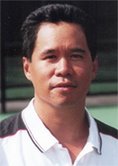The Serve:
Developing Leg Action
Doug Eng EdD, PhD
On the tour, the serve is a powerful weapon. It allows players such as John Isner, Ana Ivanovic, Ivo Karlovic and, Venus Williams to dominate their service games. But how do the pros develop such formidable serves? Or what differentiates a young person's serve, a club player's serve, and a touring pro's motion? Top coaches and biomechanists point out several key differences between these levels of players. In this article, we will focus primarily on the leg differences.

Biomechanics of the Lower Body
Although the major source of power on the serve comes from internal shoulder rotation, the base is the legs. The legs may not be the major source of power but think of them as the ignition key. Many younger players copy Andy Roddick's abbreviated backswing, but they can't get significant power until they physically mature.
Nick Saviano, the former Director of USTA's Player Development who now runs his own world-class academy in Florida, suggests that younger players have difficulty stabilizing their base, the legs. Failure to stabilized the feet undermines the kinetic chain. This chain is how power translates through the body. The first segment is the interaction of the legs and ground. Movement goes through the hips and core, then through the shoulders, and lastly, through the elbow, wrist, and hand.
Also, many club players mistime the knee bend which is critical to using the legs properly. That is, many juniors and club players will bend the knee before the toss or sway on the toss. Touring pros will toss and then sink the knees as Jim McLennan suggests (The Service Motion - Ground Reaction Forces). The pro then achieves what is known as the power position.




